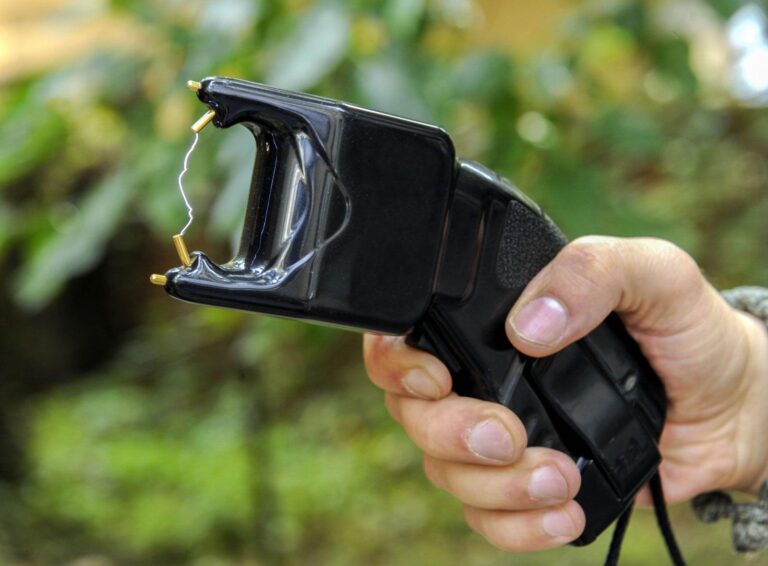Table of Contents
- Rising Adoption of Stun Guns Among Women Highlighted in Recent Safety Trends
- Effectiveness and Limitations of Stun Guns in Real-World Self-Defense Scenarios
- Legal Considerations and Regulations Surrounding Stun Gun Ownership for Women
- Expert Recommendations for Safe Usage and Training in Stun Gun Self-Defense Techniques
- Future Outlook
Rising Adoption of Stun Guns Among Women Highlighted in Recent Safety Trends
Recent market surveys and consumer reports indicate a marked increase in stun gun purchases by women, signaling a shift in personal safety strategies. The appeal lies not only in the compact design and ease of use but also in the immediate deterrent effect these devices offer. As urban environments become increasingly challenging, women are actively seeking reliable tools that provide confidence in potentially threatening situations. Retailers and manufacturers have responded by introducing models tailored to female users, featuring ergonomic grips and discreet appearances to blend seamlessly with everyday accessories.
Experts attribute this trend to increased awareness of self-defense and the desire for non-lethal protection methods. Features contributing to this rise include:
- Portability: Lightweight and pocket-sized designs allow easy carrying without discomfort.
- Effectiveness: High-voltage shocks temporarily incapacitate attackers, providing crucial escape time.
- User-Friendly: Simple activation mechanisms ensure swift response during emergencies.
Effectiveness and Limitations of Stun Guns in Real-World Self-Defense Scenarios
In real-world confrontations, stun guns have proven to be a valuable tool for many women seeking to enhance their personal safety. Their ability to deliver an immediate electrical shock can incapacitate an assailant long enough to allow the user to escape a dangerous situation. The portability and ease of use add to their appeal, making them a practical choice for those who may not have extensive self-defense training. Additionally, stun guns are often favored for being non-lethal alternatives, reducing the risk of permanent harm while still providing significant stopping power.
Despite their advantages, stun guns come with inherent limitations that users must understand. The device requires close proximity to the attacker-typically within a few inches-to be effective, which can be challenging in fast-moving or multiple-attacker scenarios. Environmental factors such as wet clothing or thick garments can also reduce the stun gun’s impact. Moreover, stun guns rely heavily on the user’s ability to remain calm and deploy the device under stress. Important considerations include:
- Legal restrictions and regulations that vary by region.
- The possibility that some assailants may have a higher tolerance or the ability to recover quickly.
- Battery life and device maintenance, which are critical for reliability.
Legal Considerations and Regulations Surrounding Stun Gun Ownership for Women
Women interested in using stun guns for personal protection must navigate a complex legal landscape that varies significantly across states and countries. Ownership restrictions often include age limits, mandatory permits, or outright bans in certain jurisdictions. Awareness of these regulations is critical to ensure compliance and avoid potential legal repercussions. For instance, some regions require buyers to complete safety training or background checks, while others limit the type and voltage of devices legally allowed.
Furthermore, carrying stun guns in public spaces frequently comes with its own set of rules. Restrictions may apply to schools, government buildings, airports, and public transportation, where possession is either prohibited or requires special authorization. Women should also be mindful of airline regulations and international travel laws related to stun guns. Staying informed through official government resources, local law enforcement agencies, and self-defense advocacy groups can help ensure safe and responsible ownership.
Expert Recommendations for Safe Usage and Training in Stun Gun Self-Defense Techniques
Proper training and adherence to safety guidelines are crucial when incorporating stun guns into self-defense routines. Experts emphasize the importance of familiarizing oneself thoroughly with the device’s operational mechanisms before practicing any defensive maneuvers. This includes learning how to hold the stun gun securely, activating it correctly under stress, and understanding the legal restrictions governing its use in your jurisdiction. Additionally, practicing with a certified instructor can enhance reaction times and confidence, ultimately leading to more effective and safer deployment in critical situations.
To maximize protection while minimizing risks, experts suggest adopting these key practices:
- Regular drills: Engage in routine simulations to ensure muscle memory and calm response during emergencies.
- Device maintenance: Check batteries and contact points frequently to avoid malfunctions when most needed.
- Situational awareness: Always be mindful of surroundings to use stun guns as a last-resort defense rather than a first response.
- Legal compliance: Stay updated on local laws regarding stun gun possession and usage to prevent legal repercussions.
Future Outlook
As stun guns continue to gain traction as a preferred self-defense tool among women, their impact on personal safety is becoming increasingly significant. While not a substitute for broader security measures or awareness, these devices offer a practical means of protection in urgent situations. Ongoing advancements in stun gun technology and accessibility are likely to further empower women to take control of their personal safety, reflecting a broader societal commitment to reducing violence and enhancing security for all.Check Our Other Blogs
- StunGun – Your Trusted Source for Stun Guns, Laws, and Self-Defense Tips
- PepperSprayLaws – Your Trusted Resource for Pepper Spray Information
- StunGunLaws – Your Trusted Guide to Stun Gun Legality and Safety





